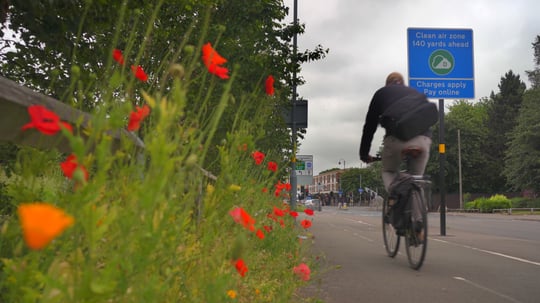De-risking Local Authority programmes like Clean Air Zones
Posted in Public Sector, Print
March 2022
5 minutes reading time
Clean Air Zones (CAZ) are big news in local authority organisations and their communities because they are critical to creating a safe and healthy environment in which people can thrive and economies can grow. But there are many challenges on the path to CAZ success, from winning over public opinion to meeting significant operational requirements.
Many local authorities are either implementing – or considering introducing – a CAZ scheme in their centres, not least because within UK law, the Environment Act 1995 requires them to monitor and review air quality and pollution against national targets.
Getting the implementation of a CAZ right requires a range of skills and capabilities that are not always core to Local Authority organisations. Research and insight driven decision making, citizen engagement, governance and security, reliable transactional mail services, are all critical to success.
So where do you start?
Our work with Birmingham City Council – helping them to execute their streamlined ‘Brum Breathes’ CAZ programme has helped us to put together the 5 questions we think it's essential to review no matter where you are on your CAZ journey…
5 considerations to help ensure CAZ success
- Where should I start when looking to roll out a Clean Air Zone?
Firstly, it’s vital for any local authority to do their research. This means getting under the skin of your users, your organisation, and your technology landscape to properly understand the state of play – well in advance of rolling out the scheme.
Behavioural insight is a powerful tool in ensuring the smooth implementation of your scheme, equipping you with deep understanding of those the zone will affect. You’ll learn just how many non-compliant cars are in the area at any one time, as well as which stakeholders will need to be engaged with and involved in the roll out.
This research phase will also help to reveal your motorists' behaviours within the zone – getting to grips with why they’re driving into the city as opposed to using other forms of transport. It will help to inform your decision on the appropriate zone to select and whether it should involve vehicle charges. And whether you’ll be required to set up alternative transport options or community-wide campaigns, to help influence commuting behaviours and encourage, healthy, active travel.
How can I effectively communicate the roll-out to residents and visitors?
The roll-out of a successful CAZ requires open communication with the community around why, when, and how the project will take place. A lack of awareness can lead to confusion and frustration, for both motorists and your organisation – which should be avoided at all costs.
The question around when to start communicating with residents, visitors, and businesses about the CAZ varies from one local authority to the next. Advice from organisations who have successfully implemented a scheme suggests ‘the sooner the better,’ with at least a one-to-two-year period to give enough time for citizens to become familiar with the proposal.

As well as adequate, clear signage and artwork – such as billboards, posters, and road markings – it’s also worth thinking about the best ways to reach your target audience. Your research phase can and should inform any campaigns you undertake.
Campaigns can include direct mail, emails, press, or social media campaigns – such as Birmingham City Council’s #BrumBreathes campaign – will ensure you reach everyone within the community. It's also worth setting up one or more physical information points at key points within the proposed CAZ, so that people can find out more details in person.
Above all, it’s important to provide context about why the scheme is needed – how it will help meet ambitious air quality standards and drive health and environmental benefits – along with the way fees and fines will be reinvested back into the community. Understanding the tangible benefits of the scheme will help residents better engage with it.
What signage will I need for the Clean Air Zone?
The exact number and type of signage options you’ll require will vary on the size of the zone you're implementing, but the Joint Air Quality Unit and Department for Transport have guidelines around dimensions, to ensure consistency, clarity, and accessibility.
The signs detailing the zone type should be in place along major access routes to clearly outline the boundaries – enabling motorists to avoid the areas if they wish. Signs should be placed at junctions prior to the start of the boundary, as well as at the start and end of a zone.
What unexpected challenges could I face when enforcing a Clean Air Zone? And how can I solve them?
It's vital that your local authority pre-empts and addresses any reasons that the scheme may be unpopular with residents and businesses. Integrating this messaging into your campaign activity and showing how fees and fines will be used to benefit the local authority, can help to mitigate any discontent.
Inevitably, some residents will be non-compliant with the scheme, so catering for the communications required to avoid a backlog of fines is critical. Local authorities can underestimate the complexity of the data required to provide these communications, as well as the volume of penalty charge notices (PCNs) that may become necessary.
If you have an in-house transactional mail department, make sure there is enough resource, capability, and capacity. You may need to outsource this to a third-party specialist like CDS.
-
How can I collect PCNs effectively and efficiently? And what other consequences might I expect?
Be aware that if you don’t have a smooth flow of PCN notices going out and a build-up accumulates, you don’t only run the risk of losing out on revenue, but your call centre capacity could also be flooded with complaints when they’re finally issued – creating significant resource challenges.For a successful implementation, your CAZ operation – from behavioural research and communication campaigns, through to print production, data integration, and the issuing of PCNs– must be quick, efficient, and accurate. Having an experienced transactional mail partner in place can help to avoid many of these headaches, allowing you to focus on running the scheme and driving the outcomes that are so important to your communities.
Key takeaways:
- Start with the research – this is the foundation of a successful CAZ
- Communicate early and efficiently with the community
- Use all relevant media including signage to communicate with the public
- Have the right operational systems in place – including a transactional mail partner – and ensure they are properly resourced
- Start planning and communicating as early as you can
We have extensive experience in working with local authorities, like Birmingham City Council and can help you to deliver large change programmes like Clean Air Zones, effectively, compliantly and efficiently.

